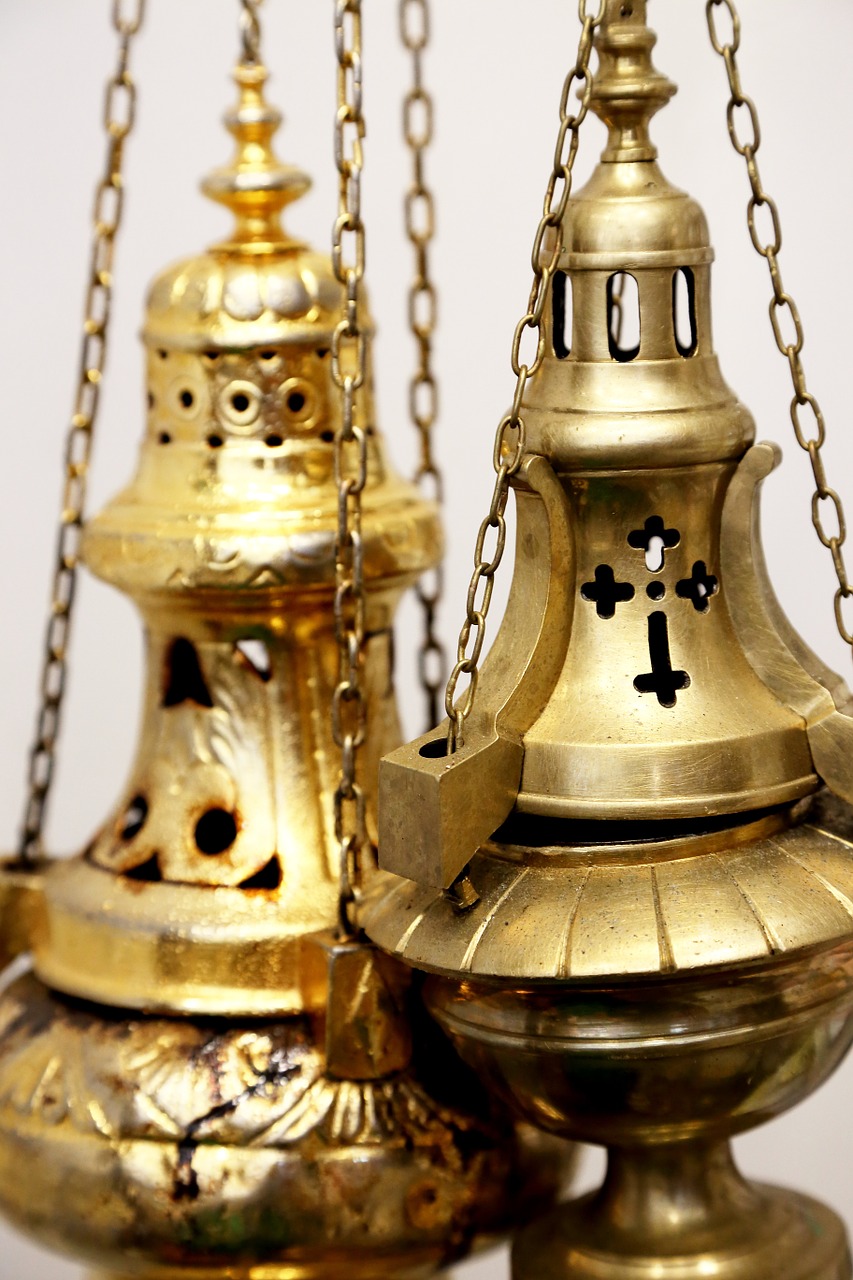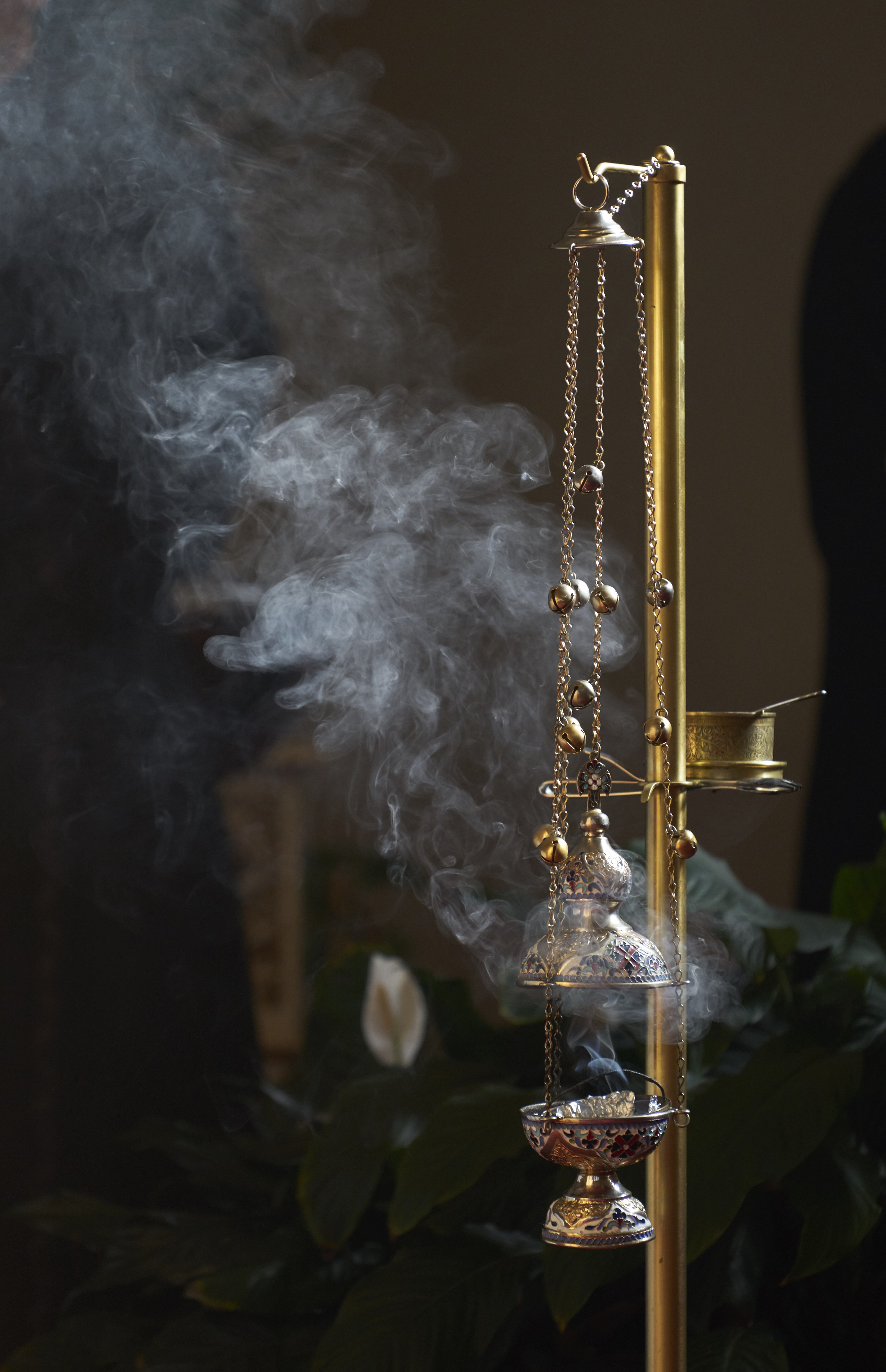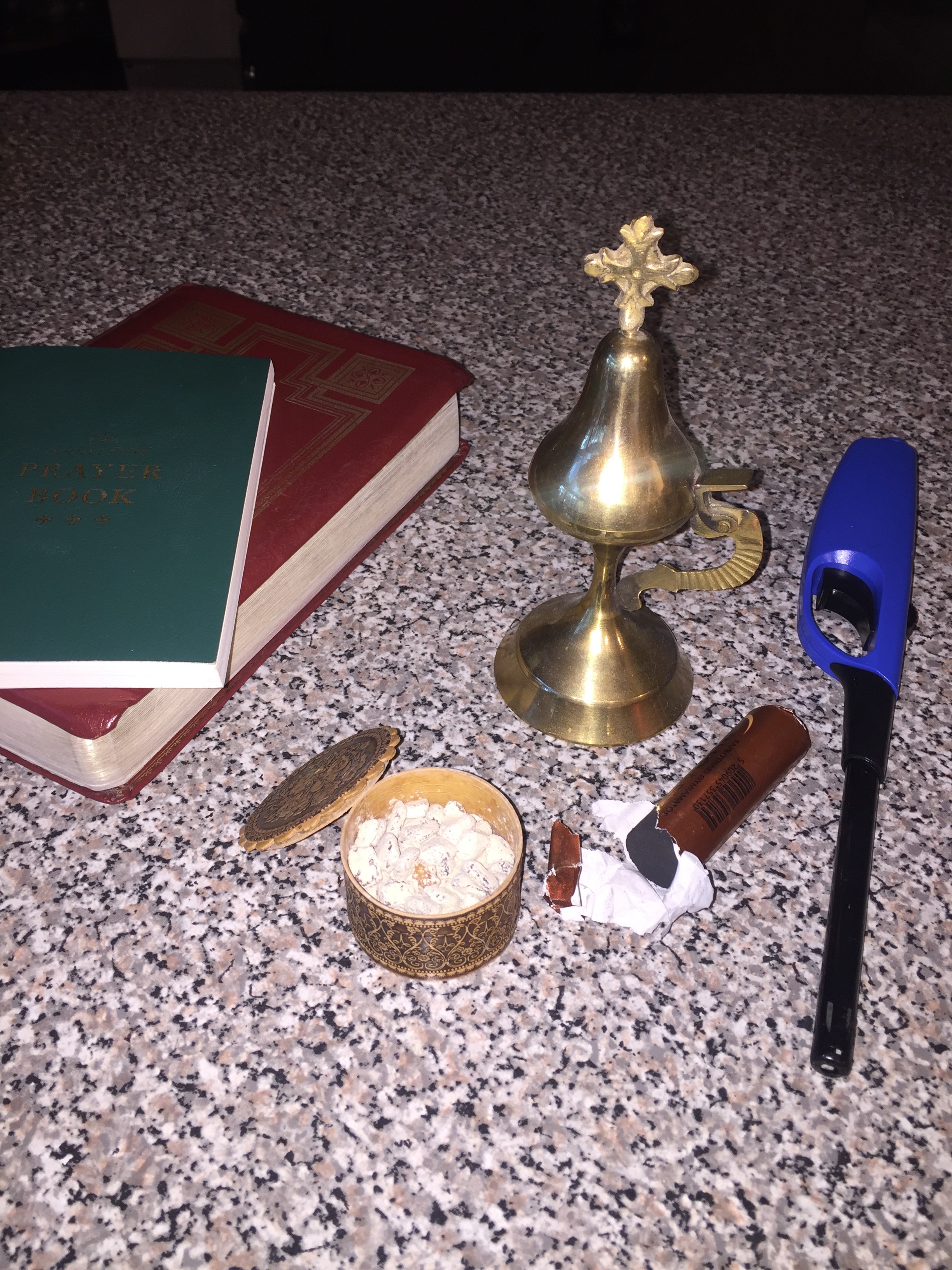[A few weeks ago we considered the physicality of Orthodoxy and the necessity of in-person services, so I thought this would be a good time to consider more deeply the beauty and symbolism of incense in worship. This post is an expanded version of one I published in September of 2019. Why another retread? Well, for one thing, it fits. But more importantly, in our intermittent series “Stumbling Stones on the Orthodox Road,” the next post will be about honoring the Virgin Mary. Like so many projects in my life, the preparation work is taking about twice as long as I expected (maybe three times). But the Virgin Mary is truly a big deal, and I want to do right by her.
As you may know, in the Ancient Faith blogosphere and podcast-o-sphere, or whatever you want to call it, most of us are volunteers; our thoughts and words are an offering of love. We do our ministry in our spare time, which can be in short supply. Fortunately, as I prayed, read, and reflected on the Virgin Mary, my semi-panicked realization of “This post is not ready!” turned to joy. I realized that by delaying, we will be considering the Virgin Mary during the beginning of the two weeks of fasting before the Dormition, one of the twelve great feasts of the Church, when we celebrate the death, assumption, and glorification of Christ’s mother, the Most-Holy Theotokos. This is providential timing. God is good, even when I’m disorganized. – LH]
On a recent weekday I was walking from my church’s fellowship hall into the nave to light a seven-day jar candle and pray for a friend in need. My thoughts were pinging around as usual, and I wasn’t feeling particularly spiritual.
But when I opened the door to the narthex, my nose—and my heart—registered a sacred truth well before my mind caught up: I had entered a holy place.
The signal came not from the sight of the sand in the candle stand or the echo of my sandals on the marble floor; it came from the lingering aroma of incense.
Before my impressions could organize themselves into words, I had breathed in a fragrance that means worship. A fragrance that means prayer. A fragrance that tells me that this place, here and now, is set apart as God’s holy temple.
The Power of Scent

I treasure the aroma of incense at my church, not only for its symbolic meaning and the added dimension of beauty that it brings to worship, but because of the way incense “speaks” to my heart. I spent the majority of my Christian life in the Evangelical world, where incense was never a part of the worship experience. My church memories are not related to any particular smell at all, except a few unintended odors: pine-scented cleaner, mildew from a roof leak on carpet, or stale food from a potluck dinner prepared in an adjacent kitchen.
But in my Orthodox life now, I am grateful to encounter that faint scent of incense every time I enter the church. It brings my attention to the Kingdom of God, providing a sensory reminder to “attend,” to silence my mind and focus my heart for worship.

I won’t pretend to understand the parts of the brain that are activated by the olfactory nerve. All I know is that our sense of smell brings powerful associations to our minds, even more so than visual cues from old photographs or the sound of Grandpa’s favorite jazz song on a scratched vinyl album.
Sometimes scent stirs sad memories. With one whiff of a certain industrial cleanser I am immediately transported back to the assisted living center where my grandparents spent their last years. The distinctive smells of a hospital corridor remind me of my mom’s final days after her stroke.
But our sense of smell also holds lovely reminders. The intoxicating aroma of sugar cookies in the oven brings back memories of a childhood kitchen at Christmastime. On a mountain hike, the earthy fragrance of pine needles and soil underfoot reminds us to slow down and enjoy the beauty just as powerfully as the scenic view and the whisper of the wind through the trees.
Incense in Scripture
God, who lovingly created us as physical, sensory beings, instructed the Israelites in the proper worship of Him. It is no coincidence that He incorporated our senses in His commands for worship, including the use of incense.
As the Israelites wandered in the wilderness, God instructed Moses,
You shall make an altar. . . . Aaron shall burn on it sweet incense every morning; when he tends the lamps, he shall burn incense on it. And when Aaron lights the lamps at twilight, he shall burn incense on it, a perpetual incense before the Lord throughout your generations. (Ex. 30:1,8 NKJV)
A perpetual incense before the Lord. Most Protestant denominations ignore the term “perpetual,” or they believe, along with John Calvin and the later Puritans, that incense in the Old Testament sacrificial system was merely a shadow or type, which Christ fulfilled; thus it is no longer necessary.
They seem to have forgotten the Book of Revelation, where St. John the Theologian writes,
Then another angel, having a golden censer, came and stood at the altar. He was given much incense, that he should offer it with the prayers of all the saints upon the golden altar which was before the throne. And the smoke of the incense, with the prayers of the saints, ascended before God from the angel’s hand. (Rev. 8:3-4, NKJV)

For a few hundred years in early Christianity, incense might not have been in use—the evidence is unclear—because of its association with emperor worship and other forms of idolatry. (Remember that thousands of Christians were martyred after refusing to burn incense to Caesar.) But incense eventually was restored to Christian worship, fulfilling the prophecy of Malachi:
“For from the rising of the sun, even to its going down,
My name shall be great among the Gentiles;
In every place incense shall be offered to My name,
And a pure offering;
For My name shall be great among the nations,”
Says the Lord of hosts. (Mal. 1:11)
The Orthodox Study Bible describes this verse as “a remarkable and clear prophecy that the Gentiles, in their worship of God, in every place or church will burn incense before Him—as Israel had done. To this day, incense is offered in nearly every service of the Orthodox Church.”
The Church Understands Human Psychology
My former priest, Fr. Lou, often reminded us that the word psychology comes from the Greek word psyche, “soul,” and, of course, -ology for “study of”: psychology means “study of the soul.” The Church understands human psychology and the ways we operate: we absorb information and meaning through our senses, not only through our intellects. Thus that physicality of Orthodox worship that we discussed recently is important and has been wrongly abandoned by other Christian groups.
Of course, incense in and of itself is not worshipful. I was a child during the hippie era, in a suburban environment that was far removed from the Haight-Ashbury district of San Francisco. Still, I vividly remember what I consider to be the Scents of the Seventies: patchouli and sandalwood. One whiff of either of them fills my mind with images of bell bottoms, leather fringe, and turquoise jewelry. Creedence Clearwater Revival is playing in the background, which is not a bad thing. But I don’t associate anything peaceful or Christ-centered with memories of those skinny sticks of incense in ceramic bowls.
In order for incense to be a part of true worship, every formulation must contain one essential ingredient: prayer. As Presvytera Georget Photos wrote in a wonderful article in Praxis,
Many cultures use incense in a variety of types and fragrances; however, when you use this common incense, you probably do not feel the same gratification or sense of peace as you do when you sit in church and savor the fragrance of the sacred incense. Common incense is missing a key ingredient: prayer. The sincerity and passion of prayer transforms incense into a vehicle to help our supplications rise to heaven. (Praxis, Vol. 8, Issue 2, Fall 2009)
We are reminded of this truth in the beloved Scripture verse chanted at every Vespers service during the censing of the temple:
Let my prayer be set before You as incense,
The lifting up of my hands as the evening sacrifice. (Ps. 140/141:2)

A Note on Allergies
Unfortunately, in our chemically oversaturated world, some people experience extreme sensitivity to incense—enough discomfort and breathing difficulties to drive them out of the church. A few years ago, a caller on Fr. Evan Armatas’s show, Orthodoxy Live, asked for advice on what to do for this kind of allergic response. Father Evan suggested standing at the perimeter of the nave, in the back near the choir, or near a vent to help with air circulation.
He also noted that some people are actually allergic to the additives or preservatives in many incense formulations, rather than the incense itself. Some purer forms of incense can eliminate this type of problem.
Additionally, incense can pose a challenge for people with a variety of disabilities, such as lung impairments or sensory processing challenges. Summer Kinard’s book from Ancient Faith Press, Of Such Is the Kingdom: A Practical Theology of Disability, offers several suggestions for handling such difficulties.
If the incense in your parish is aggravating your worship experience instead of enhancing it, please talk to your priest about possible solutions.
Incense in the Home
The holy Fathers, including St. John Chrysostom—who wrote the Divine Liturgy that we use most often today—refer to our families as the “home church.” The use of incense at home provides a beautiful way to bring tranquility and a reminder of God’s presence into our busy lives.
Presvytera Georget continues,
Orthodox faithful burn incense in their homes when they pray before their icons or as they walk around the house censing the windows and doorways, bringing a sense of peace to their homes, typically on Saturday nights or on the evenings of a Great Feast.
Incense, or livani, helps set an atmosphere of prayer and peace. It was one of the first gifts given to our Lord by one of the Three Wise Men in honor of His birth. Incense links us spiritually to God. The sweet mystical smoke that dispelled the worldly odors at Christ’s own home acts as a vessel, carrying our prayers to God.

I love this idea, but censing as a spiritual practice is a bit foreign to me. Several years ago, when I discovered that incense is not only for formal services but also for life in the home church, I took an informal, unscientific poll. My polling method consisted of blockading my cradle Orthodox friends on their way out of the fellowship hall and peppering them with questions. (Shockingly, all of them are still on speaking terms with me.) I asked them if they used incense in their homes, when and how they used it, and to recommend any accompanying prayers or psalms.
I was surprised to discover that most of them did not cense their homes, so I didn’t get much in the way of direction or ideas. (Thanks, guys!) Yet I like the idea of using incense as preparation on Saturday evenings or the evening before a feast day.
So I did some searching and found a few articles that made me a bit uncomfortable because they sounded so legalistic. Life Pro Tip: Beware of Internet Orthodoxy. All kinds of weirdness and bad theology are out there on the intertubes, masquerading as Orthodoxy. It’s always best to talk to your priest about questions of Orthopraxy, or Orthodox practice. He will have suggestions to enhance the Christ-centered atmosphere of your home without overwhelming you with rules and regulations.
The legalistic how-to’s are a bit ridiculous, because I’m pretty confident that there are no capital-T Traditions related to laypeople censing their homes. There is no ancient, second-century scroll of tips on the subject. Remember, hundreds of years ago incense was an exotic, expensive ingredient. Laypeople couldn’t cense their homes even if they wanted to. So don’t worry too much about doing things “right.”
Having said that, I did find a helpful article, “Censing at Home,” on Fr. John Whiteford’s Orthodox Christianity blog, as well as some ideas from the blog Living Orthodox Traditions. Here are some suggestions, as well as some general tips if you want to use incense as a part of your home worship.
For supplies, you will need a simple hand censer that you can purchase online or at your parish bookstore, along with rolls of charcoal and a little baggie of incense. This is available in various formulations, often from monasteries.
Place a charcoal puck in your censer and light it. It will start sizzling as a line of heat moves across the disk, and it will start to turn gray and ashy. Then, using a pair of tweezers, place about three nuggets of incense on the hot charcoal, close the lid, and you’re ready to go.
Hold the censer in your right hand and make the sign of the cross over whatever you are censing. Your home’s icon corner is a good place to begin. You can just stay put and cense the cross and gospel book in your corner, singing a hymn or reciting a Psalm. Or you can cense the whole room, perhaps making the sign of the cross over each of the four walls, and move on to the other rooms of your house.
Some Orthodox families incorporate incense into family prayer each evening. That’s setting a pretty high bar, so good for you if that’s your practice. A more manageable schedule would be to use your censer on the eves of feasts, Saturday evenings, at the start of each Lenten period, and on the eves of family members’ name days, as well as the eve of the feast of your church’s patron saint.
So what should you pray while processing around your home? Some Orthodox, as they make the sign of the Cross, recite, “This room (or bed) is blessed by the sign of the Holy Cross.” The members of the household might chant the Thrice-Holy Hymn, “Holy God, Holy Mighty, Holy Immortal, have mercy on us.” Psalm 51 (or 50 in the Septuagint) is always a meaningful go-to Psalm. You could also chant or recite the troparion of the day’s feast or the upcoming Sunday service, beginning and ending at the icon corner.

Once again, ask your priest for direction, and don’t worry too much about correct form. This is about God, not us: worshiping Him, dedicating our homes and our lives to Him, and asking the saints to pray for us. Burning incense brings the fragrance of prayer into our homes. Bless the icon corner, each member of the family, and be sure to cense the other icons in your home. You may also bless your garden with incense, honoring God’s creation.
When you’ve finished blessing your house, leave the censer at your icon corner and let it burn out. Or, if you’re in a small apartment and the smoke is getting intense, you can leave the censer outside on your balcony, blessing Creation as well as your downwind neighbors, who may or may not appreciate the gesture.
When the incense has burned out, tuck the ashy remains around the foundations of your home, in the garden, or maybe under some nearby bushes. Holy things used for worship do not belong in a trash can.
Readers, how do you incorporate incense into your homes? Are there specific prayers or psalms that you like to chant while censing, or can you recommend any resources that explain ways to establish this practice? Please share your thoughts in the Comments section below.
I am eager to learn from you!
Thank you for you remark about telling the Priest about incense sensitivities. I do believe people are hesitant to do so, fearing it’s wrong or improper somehow. Being responsible for incense supplies at 2 parishes, I was always grateful when word got to me that the incense being used “bothered” people (i.e. made it hard for them to breathe!). Needless to say, once we found out, that incense never got used again, even if it was a brand new tub of incense. There are many kinds of incense, so switching to another is an easy task.
Loved the article, gonna use it for our young new altar servers to help them understand what and why we do things we do.
I do hope people will speak up instead of suffer in silence! It’s good to know that a simple switch can make such a difference.
Thank you for such a wonderful and enlightening article! I used to make incense in Seminary (Gloria Incense from Christ the Saviour Seminary – American Carpatho-Russian Orthodox Diocese) and have always had a deep and abiding love for its use in our Church that only grew deeper when I produced it.
I think that everyone can and should enjoy the use of incense (of course, adjusting in Church and at home for any sensitivities) because of what it means for us. The cleansing of a space and devoting any place of ours, be it the Church or our “little Churches” to God and prayer is so powerful and moving.
To all those who read this and embark on incorporating incense into their personal prayer lives: may God bless you! And thank you Lynnette for such a beautiful article.
Thank you, Father, for your blessing! I’ve never known anyone who made incense. That must have been a wonderful job.
Hi Lynnette,
I listened to your current podcast posted on Ancient Faith today, and really enjoyed it! Not too long, not too short, yet full of substance. AND you’re an excellent speaker! So thanks! 🙂
After having a major health crisis and learning a lot about nutrition, chemicals in my home, etc, and becoming interested in essential oils for home use, I became a certified holistic aromatherapist because I read so much conflicting information and didn’t want to hurt my kids.
So, when I discovered the Orthodox church (long story just like every other convert, lol) I was already primed for the use of incense. But I was very disappointed to find that most incenses are made with artificial fragrance oils! Even the incense from Mt Athos! The molecules from authentic fragrances made from essential oils cross the blood brain barrier and have mental and emotional benefits, as well as having antibacterial and antimicrobial benefits (you can read a lot about this on PubMed if you’re interested.)
So, personally, I burn pure gum resins at home, which I buy in bulk and ask my priest to bless. Like a lot of converts I really love “the smells and the bells.” I burn it nearly every day, and many times twice a day.
But it’s only recently that I have heard about blessing the whole house with it, usually it just sits on my prayer altar. But it makes sense because incense is carried through the church blessing the icons, right!?! So I think I’m ready to kick it up a notch and add in some whole house blessings!
Thanks!!!